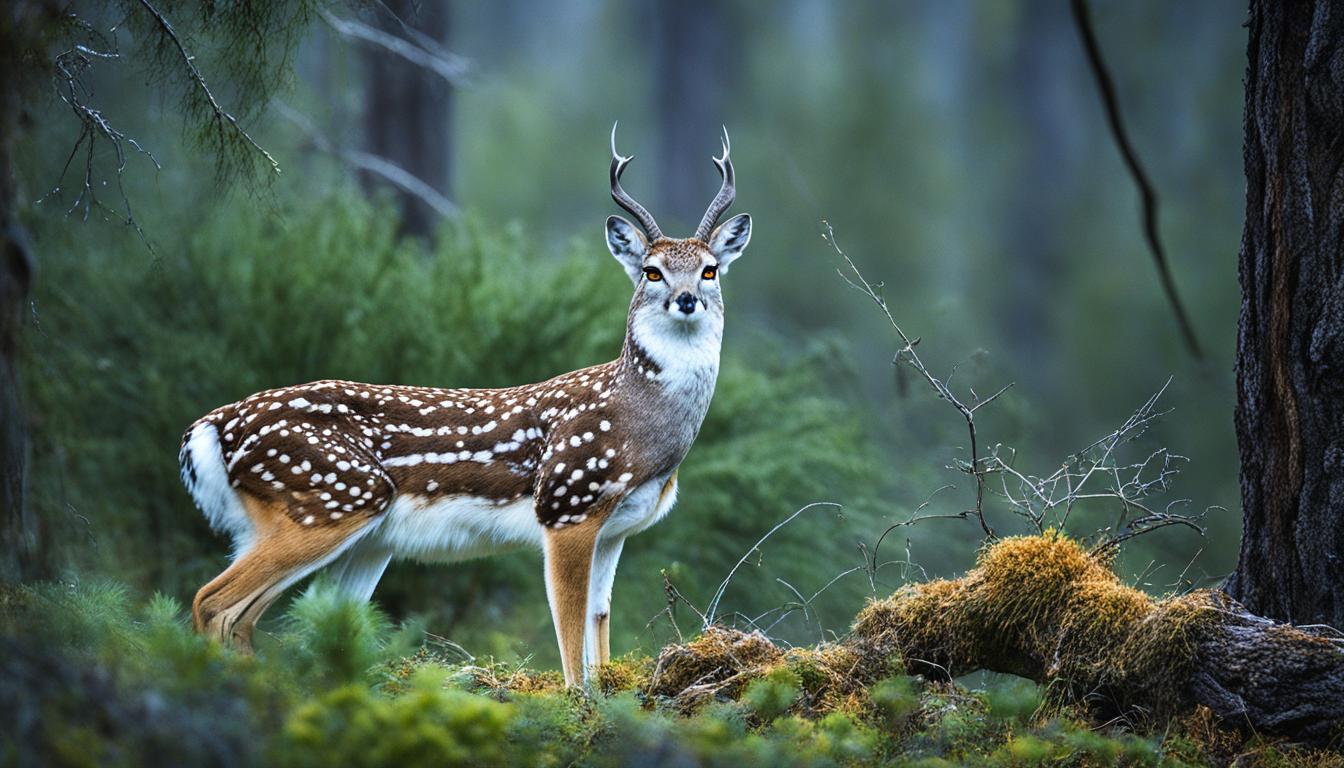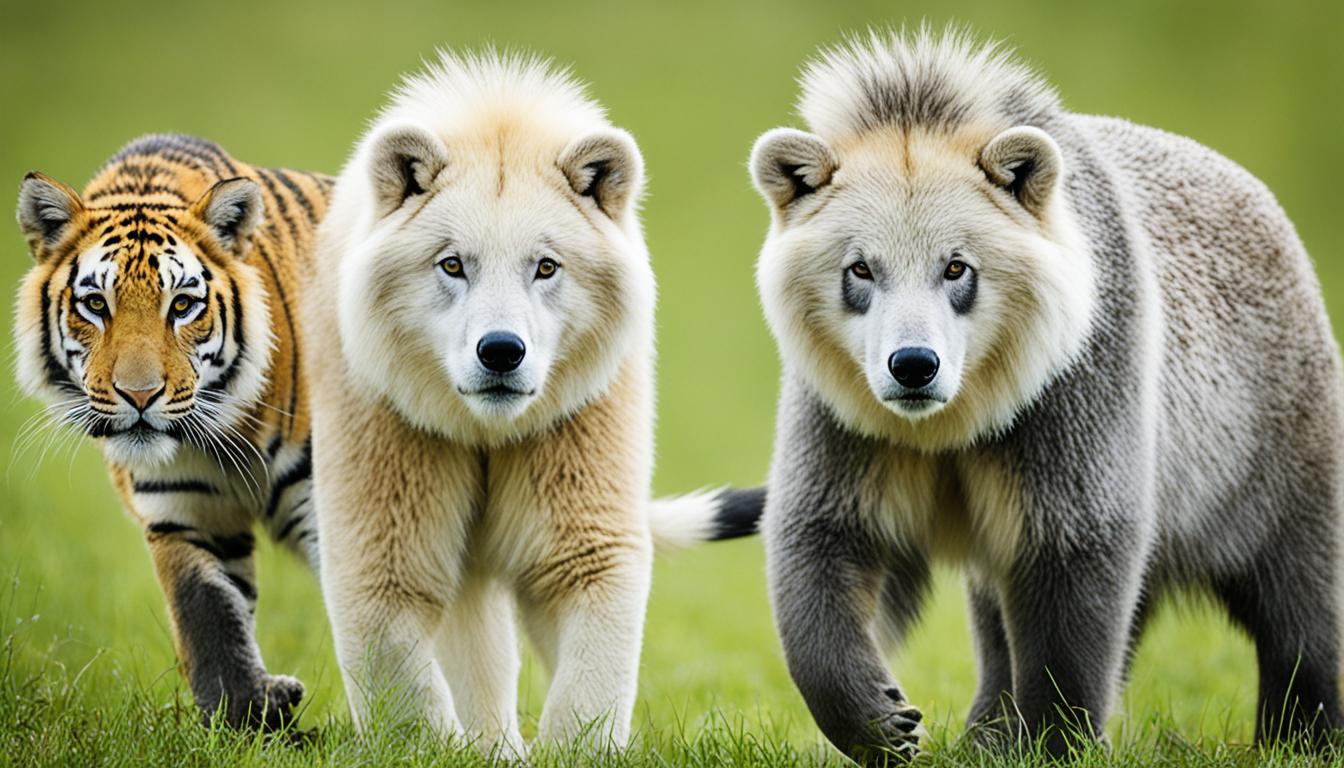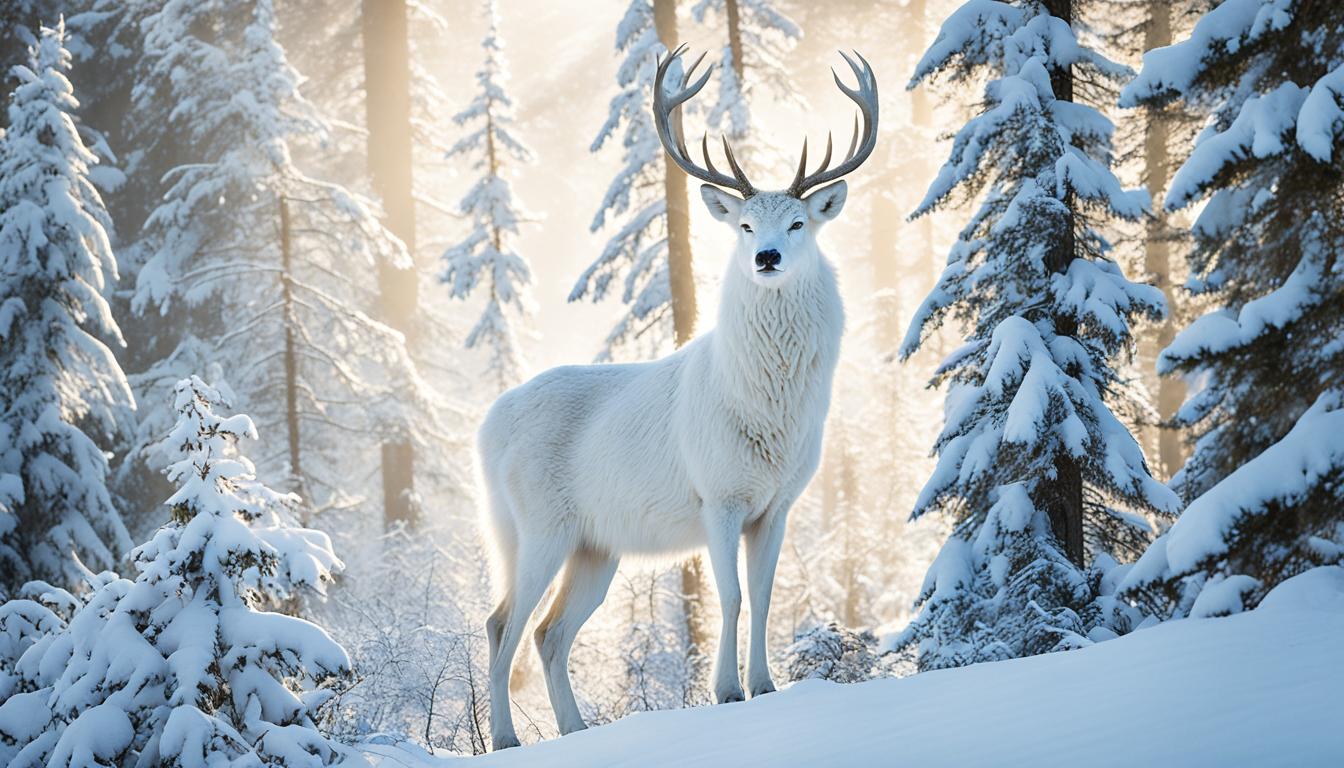Did you know there are many animals that begin with the letter S, each possessing their own distinct traits? From the tiniest marine mammal to the biggest reptile, the animal realm presents a wide variety of captivating creatures. Join us as we set out to discover these amazing beings and reveal the marvels of the natural world.
Key Takeaways:
- Animals that start with S showcase the incredible diversity of the animal kingdom.
- From the majestic saltwater crocodile to the agile siamang, each animal has its own unique features and behaviors.
- Understanding and appreciating these fascinating creatures can help us work towards their conservation and the preservation of their habitats.
- Animals that start with S include salmon, saltwater crocodile, sambar, scarab beetle, scorpion, sea otter, sea turtle, seahorse, serval, sharks, siamang, sloth, snakes, snow leopard, and more.
- Exploring the diverse world of animals that start with S offers a glimpse into the wonders of the natural world and the importance of biodiversity.
Salmon
Salmon are migratory fish known for their remarkable life-cycle. They begin their journey by hatching in freshwater rivers and streams. Once they are strong enough, they make their way to the vast Atlantic Ocean, where they spend several years maturing and growing.
One fascinating species of salmon is the Atlantic salmon (Salmo salar). These majestic fish are native to the rivers of North America and Europe. They have a silver body with black spots, and their flesh is prized for its rich flavor.
After their time in the ocean, salmon have an undeniable instinct that leads them back to their birthplace. They swim against strong currents, leaping waterfalls and surmounting any obstacles in their path, all in an effort to return to freshwater rivers and streams. This incredible journey is known as salmon’s “return run.”
Once back in freshwater, the life-cycle of salmon takes an extraordinary turn. The female salmon excavates a nest, or a “redd,” in the gravel river bed, where she deposits her eggs. The male salmon then fertilizes the eggs by releasing sperm over them. This process is known as spawning.
After the spawning is complete, the adult salmon, exhausted from their journey, succumb to their efforts and unfortunately pass away. However, their legacy lives on, as the eggs laid in the redd hatch into a new generation of salmon.
Throughout their life-cycle, salmon play a vital role in their ecosystem. They provide a crucial source of food for both terrestrial and aquatic predators, including bears, eagles, and other fish species. Their nutrient-rich bodies also enrich the surrounding environment, benefiting the entire ecosystem.
The Life-Cycle of Salmon:
| Stage | Description |
|---|---|
| 1. Spawning | The female salmon excavates a redd and deposits her eggs. The male salmon fertilizes the eggs. |
| 2. Incubation | The eggs develop and hatch into alevins, small fish still attached to their yolk sacs. |
| 3. Fry | The alevins absorb their yolk sacs and emerge as fry, ready to swim and feed. |
| 4. Parr | The fry develop into parr, acquiring vertical markings on their sides and camouflaging themselves in the river. |
| 5. Smolt | The parr undergo physiological changes, such as growing silvery scales, and prepare for their journey to the ocean. |
| 6. Migration | The smolts make their way downstream to the ocean, facing various challenges and predators along the way. |
| 7. Ocean Phase | The salmon spend several years in the ocean, growing and maturing. |
| 8. Return Run | The adult salmon navigate back to their birthplace, facing obstacles and incredible feats of strength. |
| 9. Spawning | The cycle begins anew as the adult salmon spawn and pass away, ensuring the continuation of their species. |
Salmon, particularly the Atlantic salmon, are not only integral to the ecosystem but also important economically. They support commercial and recreational fisheries, providing a livelihood for many individuals and communities.
As we marvel at the remarkable life-cycle of salmon, it is essential that we recognize the need to protect their habitats and ensure sustainable fishing practices. By doing so, we can help preserve these incredible fish species for future generations to enjoy.
Saltwater Crocodile
The saltwater crocodile, also known as Crocodylus porosus, holds the title of being the largest reptile in the world. Growing up to an impressive length of 6.3 meters and weighing up to 1,000 kilograms, these crocodiles are truly remarkable creatures. Found in Southeast Asia and Australia, they are known for their ability to make long journeys by sea, which adds to their allure and adaptability.
Saltwater crocodiles can be found in a variety of habitats, showcasing their versatility and wide-ranging distribution. They can be spotted in coastal areas such as beaches, as well as in estuaries, freshwater rivers, and even swamps. Their ability to thrive in different environments contributes to their status as one of the most formidable creatures in the animal kingdom.
If you ever come across a saltwater crocodile, it is important to exercise caution and maintain a safe distance. These impressive reptiles are known for their powerful jaws and are apex predators in their ecosystem. With their strength and size, they play a crucial role in their respective habitats.
Below is a table highlighting some key characteristics of the saltwater crocodile:
| Species | Length | Weight | Habitat |
|---|---|---|---|
| Saltwater Crocodile | Up to 6.3 meters | Up to 1,000 kilograms | Coastal areas, estuaries, freshwater rivers, swamps |
Note: The values provided in the table are approximate and can vary among individuals.
As we continue to explore the incredible world of animals that start with S, the saltwater crocodile stands out as a fascinating and awe-inspiring creature. Its size, strength, and adaptability make it a true marvel of the reptile kingdom.

Sambar
The sambar, scientifically known as Rusa unicolor, is the third-largest species of deer, following the moose and elk. These magnificent creatures are primarily found in the lush tropical forests of southern Asia.
Female sambars prefer to form small herds, while male sambars are typically solitary outside the mating season. These elegant deer are known for their impressive antlers and distinctive brown coat.
| Physical Features | Habitat |
|---|---|
| Sambar deer have a stocky build with a shoulder height of around 120-150 cm. | They inhabit a variety of ecosystems, including dense forests, grasslands, and marshy areas. |
| Their coats exhibit shades of brown and gray, providing excellent camouflage in the forest. | The sambar’s preferred habitat consists of areas with access to water and an abundance of vegetation. |
| Their impressive antlers can grow up to 110 cm long and are usually adorned with several tines. | These deer are commonly found in countries such as India, Sri Lanka, Nepal, and Indonesia. |
In the wild, sambars face various threats, including habitat loss due to deforestation and hunting. Predators, such as tigers, are natural adversaries of the sambar. However, these resilient deer continue to inhabit the forests of Asia, captivating those fortunate enough to catch a glimpse of their majestic presence.

Interesting Facts about Sambar
- Male sambars are known for their loud, resonant calls during the mating season.
- Sambars have a diverse diet, consisting of grasses, fruits, leaves, and even bark.
- These deer have a keen sense of smell and hearing, which helps them detect potential threats.
- Sambar populations are considered stable, despite localized declines in certain regions.
- Sambar venison is highly prized in some cultures and is considered a delicacy.
Scarab Beetle
Scarab beetles are fascinating creatures that belong to the family Scarabaeidae. These round-bodied beetles encompass a diverse group of species, including dung beetles, rhinoceros beetles, rose chafers, and goliath beetles, which hold the title of being the largest beetles in the world. With over 30,000 species, scarab beetles showcase the incredible variety within the insect kingdom.
One of the notable members of the scarab beetle family is the dung beetle. These beetles have a unique feeding and nesting behavior, as they primarily rely on dung for sustenance and reproduction. They play an essential ecological role by recycling animal waste and contributing to nutrient cycling in the environment.
Another intriguing scarab beetle species is the rhinoceros beetle. Known for their prominent horns that resemble those of rhinoceroses, these beetles are among the largest and strongest insects. They use their horns for combat with other males and to dig tunnels for mating and egg-laying.

“Scarab beetles are a true marvel of nature, with their diverse forms and adaptations. From the industrious dung beetles to the mighty rhinoceros beetles, these creatures captivate us with their remarkable behaviors and intricate evolutionary designs.”
Scorpion
Scorpions are fascinating creatures that belong to the arachnid family. With their large pincers and a segmented tail that bends forward over the body, they are instantly recognizable. There are approximately 1,750 species of scorpions found worldwide, each with its unique characteristics and habitats.
One of the most distinctive features of scorpions is their venomous sting. Located at the tip of their tail, the venom is used to kill or immobilize their prey and acts as a defense mechanism against predators. While scorpion stings are known to be painful, they are rarely fatal to humans.
Scorpions play a crucial role in their ecosystems as efficient predators, feeding on insects, spiders, and other small arthropods. They are adaptable creatures, able to thrive in a wide range of environments, from deserts and forests to grasslands and caves. The ability of scorpions to survive in diverse conditions is a testament to their resilience and survival strategies.
“Scorpions are enigmatic creatures with a long evolutionary history. Their ability to adapt and survive in various environments makes them truly remarkable.” – Dr. Sarah Thompson, Arachnologist
Interesting Facts about Scorpions
- Scorpions have a lifespan ranging from 2 to 10 years, depending on the species.
- The largest species of scorpion is the Asian forest scorpion, which can grow up to 8 inches (20 cm) in length.
- Scorpions are nocturnal creatures, preferring to hunt and explore during the night.
- Some scorpions are bioluminescent, meaning they emit a greenish-blue glow under ultraviolet light.
Types of Scorpions
| Common Name | Scientific Name | Location |
|---|---|---|
| Arizona Bark Scorpion | Centruroides sculpturatus | Southwestern United States and Northern Mexico |
| Black Thick-tailed Scorpion | Parabuthus leiosoma | Africa |
| Deathstalker Scorpion | Leiurus quinquestriatus | Middle East and North Africa |
| Emperor Scorpion | Pandinus imperator | West Africa |
| Forest Scorpion | Heterometrus species | Tropical rainforests of Southeast Asia |
Scorpions are intriguing arachnids that have captivated humans for centuries. Their unique appearance, venomous sting, and impressive survival skills make them a remarkable part of the animal kingdom. By studying and understanding these creatures, we can deepen our appreciation for the diverse and intricate world of arachnids.

Sea Otter
The sea otter, scientifically known as Enhydra lutris, is the smallest marine mammal and the heaviest member of the weasel family. They inhabit the coastal regions of Canada, Alaska, the west coast of the USA, and Russia. Sea otters have adapted to life in the sea and rarely venture more than 1 kilometer from the shore.
These adorable creatures have a dense waterproof fur that keeps them warm in the cold ocean waters. Sea otters spend much of their time floating on their backs, using rocks as tools to crack open shellfish and other prey. They have a varied diet that includes shellfish, crustaceans, worms, and fish, which they forage for among the kelp and on the sea bed.
Sea otters play a crucial role in maintaining the health of coastal ecosystems. Their feeding habits help control populations of sea urchins, which in turn allows kelp forests to flourish. These underwater forests serve as vital habitats for a wide variety of marine life.
Let’s take a closer look at the sea otter:
| Feature | Details |
|---|---|
| Scientific Name | Enhydra lutris |
| Family | Mustelidae (Weasel Family) |
| Habitat | Coastal regions of Canada, Alaska, the west coast of the USA, and Russia |
| Diet | Shellfish, crustaceans, worms, fish |
| Behavior | Floats on back, uses rocks as tools, forages in kelp, and on the sea bed |
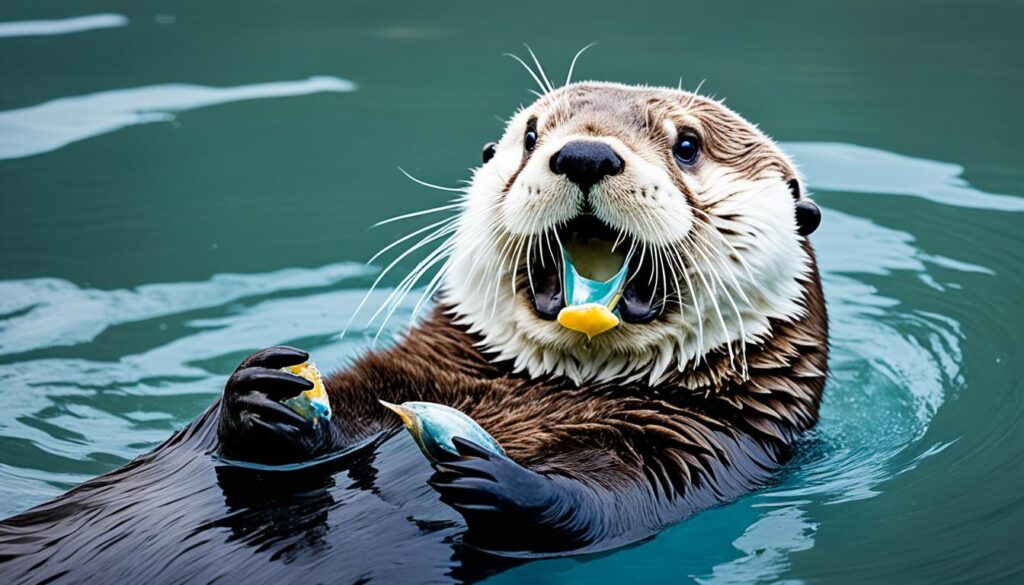
Sea Turtle
Sea turtles are majestic creatures inhabiting the vast oceans worldwide. Belonging to the family Cheloniidae, these large reptiles play a vital role in maintaining the balance of marine ecosystems. Unfortunately, the future of sea turtles is grim, as all species face threats and some are critically endangered.
There are seven recognized species of sea turtles, each with its unique characteristics and habitats. Let’s take a closer look at these remarkable creatures:
- Hawksbill Sea Turtle (Eretmochelys imbricata) – Known for its beautiful shell, hawksbill turtles mainly feed on sponges and are found in tropical and subtropical waters.
- Olive Ridley Sea Turtle (Lepidochelys olivacea) – These agile swimmers nest en masse and are known for their synchronized nesting behavior.
- Green Sea Turtle (Chelonia mydas) – Named for the green color of their fat, green turtles graze on seagrasses and algae, contributing to the health of coral reefs.
- Leatherback Sea Turtle (Dermochelys coriacea) – The largest of all sea turtle species, leatherbacks lack a hard shell and have the ability to dive to incredible depths.
- Kemp’s Ridley Sea Turtle (Lepidochelys kempii) – Found primarily in the Gulf of Mexico, Kemp’s ridleys face numerous threats, particularly from fishing activities.
- Loggerhead Sea Turtle (Caretta caretta) – With their large heads and powerful jaws, loggerheads are well adapted for crushing and consuming hard-shelled prey.
- Flatback Sea Turtle (Natator depressus) – Endemic to the waters off Australia, flatback turtles have a unique flattened shell and are primarily found in shallow coastal areas.
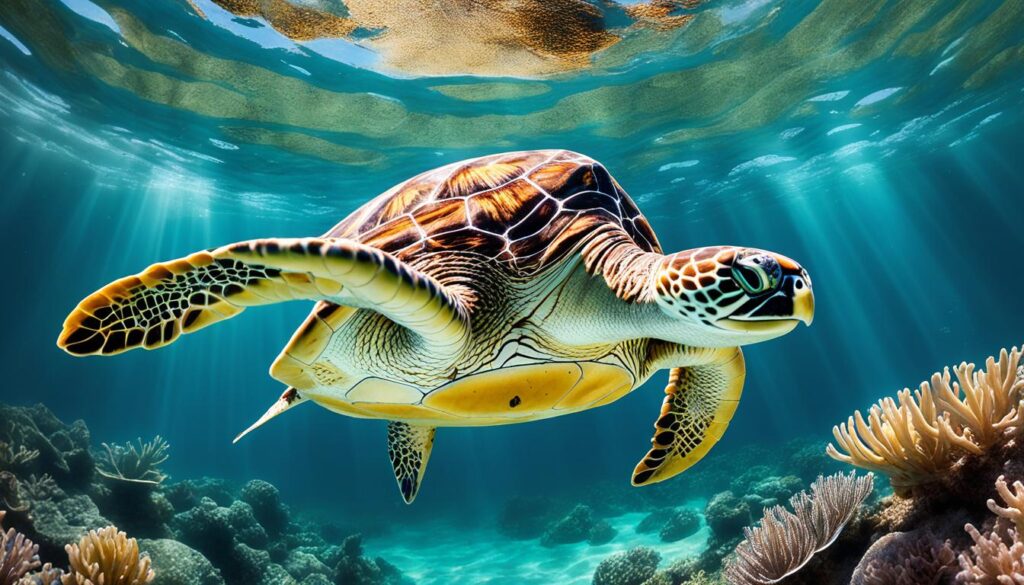
Sea turtles go through a remarkable life cycle, beginning as tiny hatchlings emerging from nests buried on sandy beaches. They instinctively make their way to the ocean, facing numerous predators and challenges along the way. Once at sea, they embark on a journey that can span several years, traversing vast distances and exploring different marine habitats.
When it’s time for adult sea turtles to mate, they return to their birthplace, guided by an innate ability to navigate the vast oceans. Female turtles haul themselves onto beaches to lay their eggs, undertaking a deeply moving and awe-inspiring ritual. The survival of sea turtles depends on the protection and preservation of their nesting sites and the reduction of threats throughout their foraging grounds.
“The sea, once it casts its spell, holds one in its net of wonder forever.” – Jacques Cousteau
Sea turtles face numerous threats that have pushed them to the brink of extinction. These challenges include:
- Climate change, which affects nesting sites and alters ocean temperatures
- Pollution from plastics and debris, leading to entanglement and ingestion
- Destruction of habitats like coral reefs and seagrass beds
- Illegal trade of sea turtle products, such as eggs, meat, and shells
- Bycatch in fishing gear, resulting in accidental capture and death
Efforts are underway to protect and conserve sea turtles, including the establishment of protected areas, conservation programs, and raising public awareness.
Seahorse
Seahorses, belonging to the genus Hippocampus, are unique fish with a fascinating appearance. They have horse-like heads, upright bodies, and distinctive curled tails. One of the most remarkable things about seahorses is their swimming style—they swim vertically instead of horizontally like most fish. They use their small fins to propel themselves along, creating a mesmerizing sight.
Seahorses hold a special record—they are the world’s slowest-swimming fish. Their gentle movements and unhurried pace make them captivating to observe. Their leisurely swimming speed adds to their charm and uniqueness within the marine world.
Seahorses can be found in coastal waters around the world, inhabiting coral reefs, seagrass beds, and mangrove forests. They prefer habitats with plenty of hiding spots, using their ability to change color to blend in and evade predators. Seahorses also sport bony plates instead of scales, providing them with an extra layer of protection.
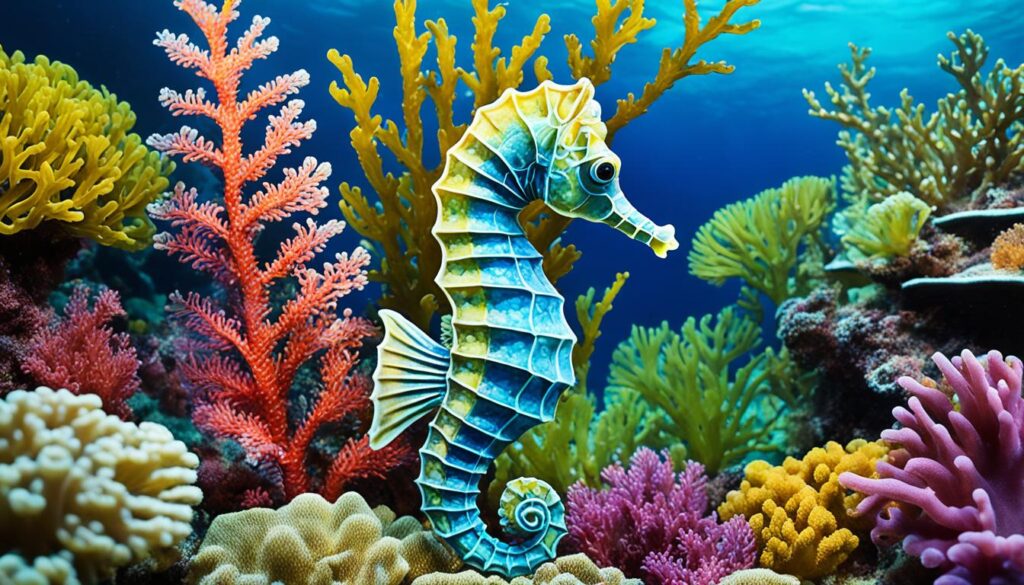
Serval
The serval (Leptailurus serval) is a fascinating wild cat species found in Africa. It boasts remarkable physical features, including the longest legs and ears in proportion to body size among all cats. Let’s dive into the world of the serval and uncover the secrets of this efficient hunter.
Equipped with its exceptional agility and speed, the serval exhibits incredible hunting prowess. It has a success rate of around 50% in its hunting attempts, making it an efficient predator in the African savannas.
The Servant’s Unique Adaptations
The serval possesses several adaptations that enable its efficient hunting techniques:
- Long Legs: The serval’s long legs give it an advantage in spotting prey from a distance and effectively pouncing on it.
- Elongated Ears: With its large ears, the serval possesses remarkable hearing abilities, allowing it to detect even the faintest sounds of potential prey.
- Sharp Vision: The serval’s keen eyesight helps it identify prey, especially small mammals, in low-light conditions.
- Flexible Body: Its flexible body allows the serval to swiftly maneuver through dense vegetation, facilitating successful hunting attempts.
- Pouncing Technique: The serval employs a unique hunting technique called “pounce-hunting,” where it leaps high into the air to catch birds in flight or pounce on small mammals hiding in the grass.
The serval’s hunting skills and adaptations make it one of the most proficient hunters in the animal kingdom.
Conservation Status
While the serval’s hunting abilities are incredibly impressive, this magnificent feline faces various challenges in the wild.
The destruction of its natural habitat, illegal hunting, and the pet trade have led to a decline in serval populations, making them vulnerable to extinction. It is crucial to prioritize conservation efforts and protect their habitats to ensure the survival of this remarkable species.
| Characteristics | Details |
|---|---|
| Scientific Name | Leptailurus serval |
| Family | Felidae |
| Habitat | African savannas, grasslands, and wetlands |
| Diet | Primarily small mammals, such as rodents, hares, and birds |
| Weight | 8-18 kg (18-40 lb) |
| Length | 85-110 cm (33-43 in) |
| Conservation Status | Near Threatened |

“The serval’s sleek and agile physique, combined with its successful hunting techniques, truly showcases the wonders of nature’s engineering.” – Wildlife Expert
By understanding and appreciating the serval’s role as an efficient hunter, we can contribute to their conservation and help protect the delicate balance of ecosystems in which they thrive.
Sharks
Sharks, belonging to the class Chondrichthyes, are a fascinating group of fish known for their sharp teeth, cartilaginous skeletons, and diverse species. As apex predators, sharks play a crucial role in maintaining the balance of marine ecosystems.
With their powerful bodies and streamlined shapes, sharks are the masters of the ocean. They have evolved over millions of years to become efficient hunters, equipped with an array of senses that allow them to detect even the slightest movement in the water. Their keen sense of smell enables them to locate prey from miles away, while their electroreceptors help them detect the electrical signals emitted by potential victims.
Sharks come in a variety of shapes and sizes, ranging from the massive great white shark to the sleek and agile tiger shark. Each species has its unique adaptations and hunting strategies, making them well-suited to their specific environments.
Did you know? “Contrary to popular belief, not all sharks are fierce man-eaters. In fact, the majority of shark species are harmless to humans and play a crucial role in maintaining the health of our oceans.”
Sharks occupy a variety of niches within marine ecosystems. Some species, like the whale shark, are filter-feeders that consume plankton, while others, such as the bull shark, are opportunistic predators that feed on a wide range of prey, including fish, seals, and even other sharks.
The Great White Shark: A Magnificent Predator
One of the most iconic shark species is the great white shark. With its powerful bite, immense size, and sleek, torpedo-shaped body, the great white has earned a fearsome reputation. However, its role in the ocean goes beyond being a mere predator.
The great white shark, also known as Carcharodon carcharias, is a keystone species that helps regulate the populations of its prey, such as seals and sea lions. By keeping these populations in check, the great white shark helps maintain the overall health of the marine ecosystem.

| Shark Species | Size | Diet |
|---|---|---|
| Great White Shark | Up to 6 meters | Seals, sea lions, fish |
| Tiger Shark | Up to 5 meters | Fish, marine mammals, sea turtles |
| Hammerhead Shark | Up to 6 meters | Stingrays, fish, squid |
Sharks, with their ancient lineage and vital ecological role, deserve our respect and protection. As humans, it is our responsibility to conserve their habitats and ensure their survival for future generations to witness the majesty of these apex predators of the sea.
Siamang
The siamang, scientifically known as Symphalangus syndactylus, is an endangered gibbon species found in Malaysia, Thailand, and Sumatra. These fascinating primates have distinctive features that set them apart from other gibbons.
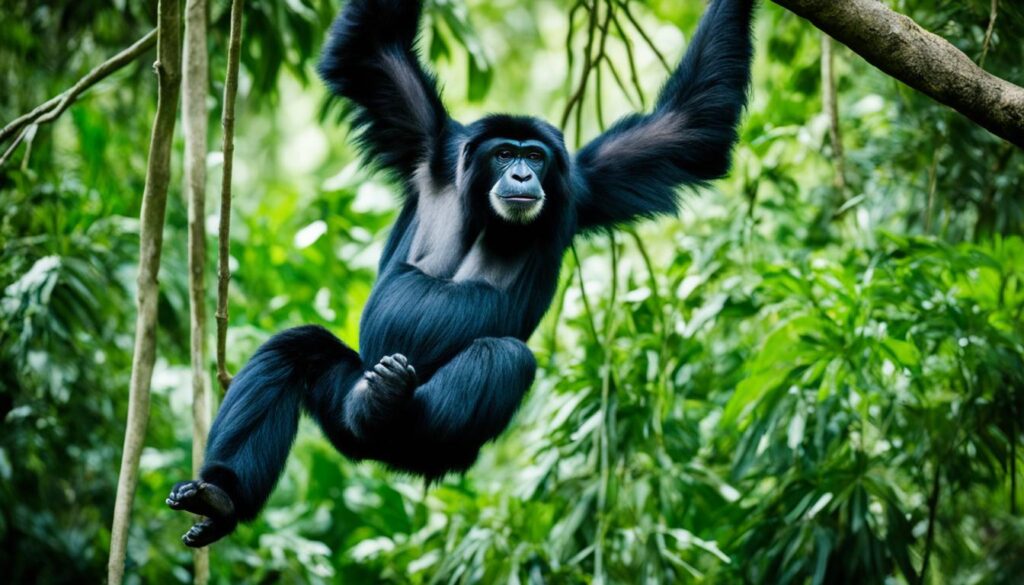
One notable characteristic of the siamang is its black fur, which provides excellent camouflage in the dense rainforest canopies where they reside. They are also recognized for their disproportionately long arms, which are highly adapted for swinging through trees.
Another unique feature of the siamang is the presence of a large throat pouch called a gular sac. This sac acts as a resonating chamber, allowing siamangs to produce resonant calls that can carry through the forest, helping them communicate with other siamangs and establish territory boundaries.
Siamangs are remarkable brachiators, skilled at moving through the forest canopy using only their arms. Their extremely flexible wrists and long arms enable them to swing effortlessly between branches, covering impressive distances with great agility and speed.
Considering their endangered status, it is crucial to raise awareness about the siamang and support conservation efforts for their protection. Preserving their natural habitat is essential for the long-term survival of this remarkable gibbon species.
Sloth
Sloths are fascinating arboreal mammals that inhabit the lush rainforests of Central and South America. These slow-moving creatures have captivated the world with their unique lifestyle and appearance.
Living their lives among the treetops, sloths spend the majority of their time hanging upside down from branches. This remarkable adaptation allows them to conserve energy and blend in with their environment.

The sloth’s leisurely pace is a result of their slow metabolism and low muscle density. Despite their seemingly sluggish nature, sloths are well-adapted to their arboreal lifestyle. Their large claws enable them to grip tree branches firmly, while their long limbs allow them to move gracefully among the canopy.
One of the most intriguing aspects of sloths is their unique fur ecosystem. Their coarse fur provides a perfect environment for algae to thrive, giving them a greenish tint. This natural camouflage helps them blend in with the surrounding foliage, providing them with additional protection from predators.
Sloths are divided into two main groups: two-toed sloths and three-toed sloths. While their names suggest a difference in toe count, the distinction lies in the number of vertebrae in their necks. Two-toed sloths have eight or nine neck vertebrae, allowing them more flexibility, while three-toed sloths have only five to seven neck vertebrae.
These unique creatures play a vital role in the rainforest ecosystem as seed dispersers. The fruits and leaves they consume and excrete promote the growth and diversity of plant life in their habitat. Additionally, their slow movements help them avoid detection by predators.
| Sloth Facts | Details |
|---|---|
| Average Lifespan | 20 to 30 years |
| Preferred Habitat | Rainforests of Central and South America |
| Feeding Habits | Herbivorous – feeds mainly on leaves |
| Unique Adaptation | Slow metabolism and low muscle density |
| Conservation Status | Dependent on the species, varying from least concern to critically endangered |
Observing the tranquil lifestyle of sloths reminds us of the beauty and resilience of nature. Despite their seemingly slow pace, sloths are a testament to the remarkable diversity and adaptability of life on our planet.
Snakes
Snakes are fascinating reptiles that belong to the order Squamata. With their long, limbless bodies and unique adaptations, they have captivated humans for centuries. Snakes lack eyelids and external ears, but their other senses, such as heat detection and excellent vibrations, compensate for these deficiencies. They display a remarkable variety of movement patterns, including the common side-to-side motion that is often associated with their slithering locomotion.
When considering the diversity of snakes, it is truly remarkable. There are over 3,900 known snake species, ranging from tiny thread snakes to massive pythons and boas. Out of these, around 725 species are venomous, equipped with specialized glands that produce venom for various purposes such as prey capture and self-defense.
“The fascination with snakes lies in their elegant yet enigmatic nature. From their striking colors and patterns to their formidable venomous stings, snakes command both fear and respect.”
Snake bites carry significant implications for human health. Each year, an estimated 100,000 fatalities occur as a result of snakebite envenomation, emphasizing the importance of education, prevention, and proper medical treatment.
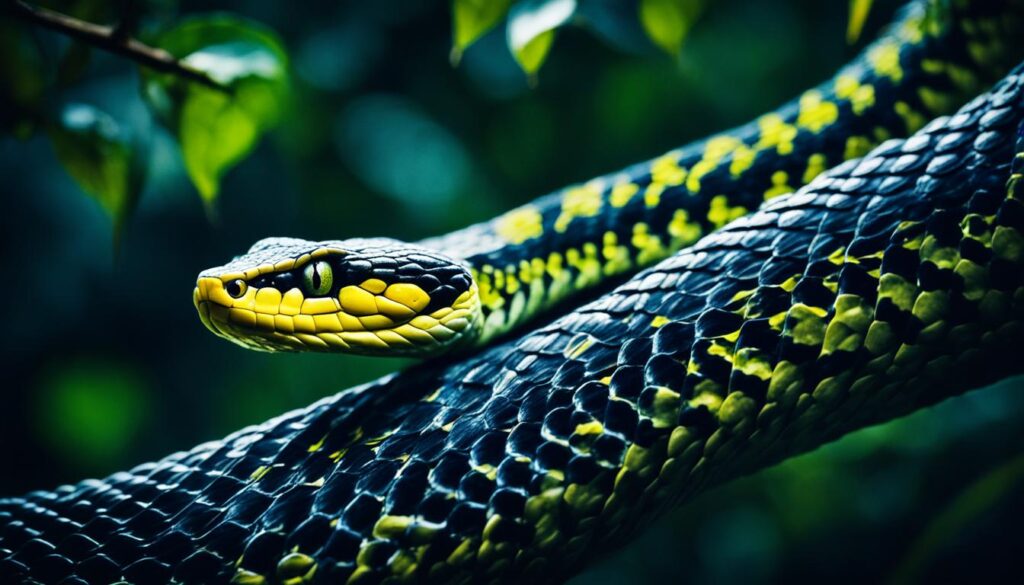
Snake Facts:
- Snakes belong to the reptile class, which also includes lizards, crocodiles, and turtles.
- They possess a unique jaw structure that allows them to swallow prey much larger than their own head size.
- Snakes play crucial roles in ecological balance by regulating populations of prey species.
- Some snake species are known for their remarkable defensive behaviors, such as flattening their bodies or rattling their tails to deter potential threats.
- Snake venoms vary widely in composition and potency, with some species possessing neurotoxic venom while others have hemotoxic or cytotoxic venom.
Snakes are a testament to the remarkable diversity of life on our planet. From their unique biology to their intricate ecological roles, these creatures continue to inspire awe and fascination. Understanding and respecting the complexities of snakes can help us better appreciate the biodiversity of our world and promote their conservation for future generations to enjoy.
Snow Leopard
The snow leopard (Panthera uncia) is a large cat species found in the mountainous regions of Asia. It is known for its stunning appearance, with a thick gray fur patterned with dark spots, providing excellent camouflage in its snowy habitat. Snow leopards are part of the Panthera genus, which also includes lions, tigers, jaguars, and leopards. However, they have unique adaptations that allow them to thrive in the harsh conditions of their mountainous homes.
Unfortunately, snow leopards are endangered, facing numerous threats to their survival. Due to habitat loss, poaching, and climate change, their population has steadily declined. To protect these magnificent creatures, conservation efforts are underway to safeguard their habitats and raise awareness about their importance in the ecosystem.
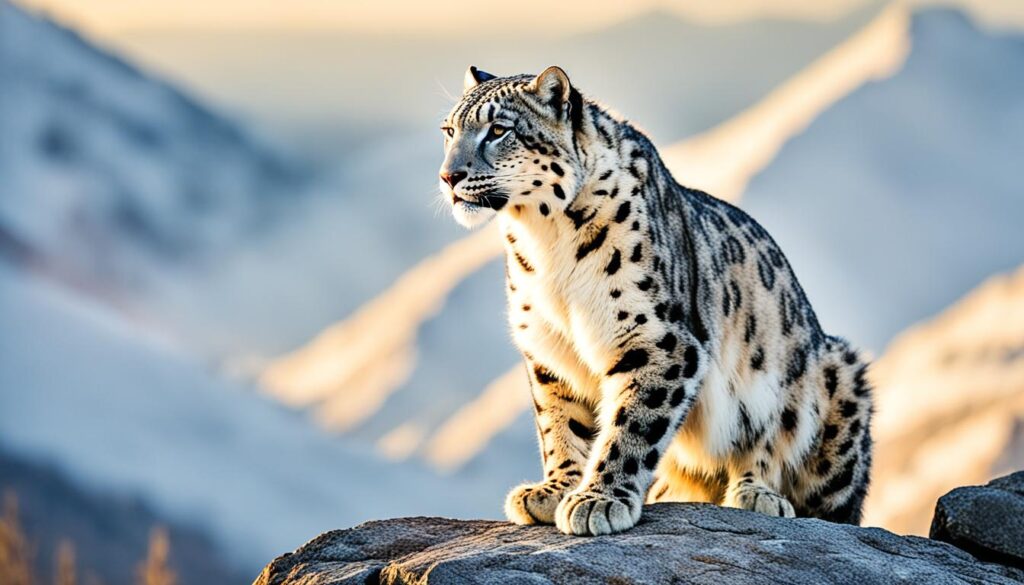
Characteristics of Snow Leopards
Here are some key characteristics of snow leopards:
- Size and Weight: Snow leopards are smaller than other big cat species, with males weighing between 60-120 kg (132-264 lbs) and females weighing between 25-40 kg (55-88 lbs).
- Adaptations: They have long and powerful hind legs, allowing them to leap across vast distances, climb steep mountains, and navigate rocky terrains.
- Habitat: Snow leopards are found in the high-altitude regions of Central and South Asia, including countries like Nepal, India, China, and Bhutan.
- Behavior: They are solitary animals, typically avoiding interactions with humans and other animals. Their elusive nature and excellent camouflage make them challenging to spot.
- Diet: Snow leopards primarily feed on blue sheep, ibex, marmots, and other small mammals found in their habitat. Their long tails help them maintain balance while traversing rugged landscapes.
Conservation organizations, along with local communities and governments, are working together to protect snow leopards and their habitats. By implementing measures such as anti-poaching efforts, habitat preservation, and promoting sustainable livelihoods for local communities, we can ensure the long-term survival of this magnificent species.
Conclusion
Exploring the world of animals that start with S reveals the incredible diversity and beauty of the animal kingdom. From the mighty saltwater crocodile to the gentle sea otter, each animal has its unique features and plays a vital role in our planet’s ecosystems.
Salmon, saltwater crocodiles, and sambars contribute to the balance of their respective habitats, while scarab beetles and scorpions have adapted fascinating traits for survival. Sea otters, sea turtles, and seahorses are small wonders of the oceans, while servals and sharks showcase the diversity of terrestrial and marine predators. Siamangs, sloths, and snakes represent the incredible adaptations and behaviors found in arboreal mammals and reptiles. Finally, the snow leopard, with its elusive beauty, reminds us of the importance of conservation efforts.
By understanding and appreciating these fascinating creatures, we can work towards their conservation and the preservation of their habitats. Let us protect and cherish the animals that start with S, ensuring a future where they can thrive alongside us on our planet.
